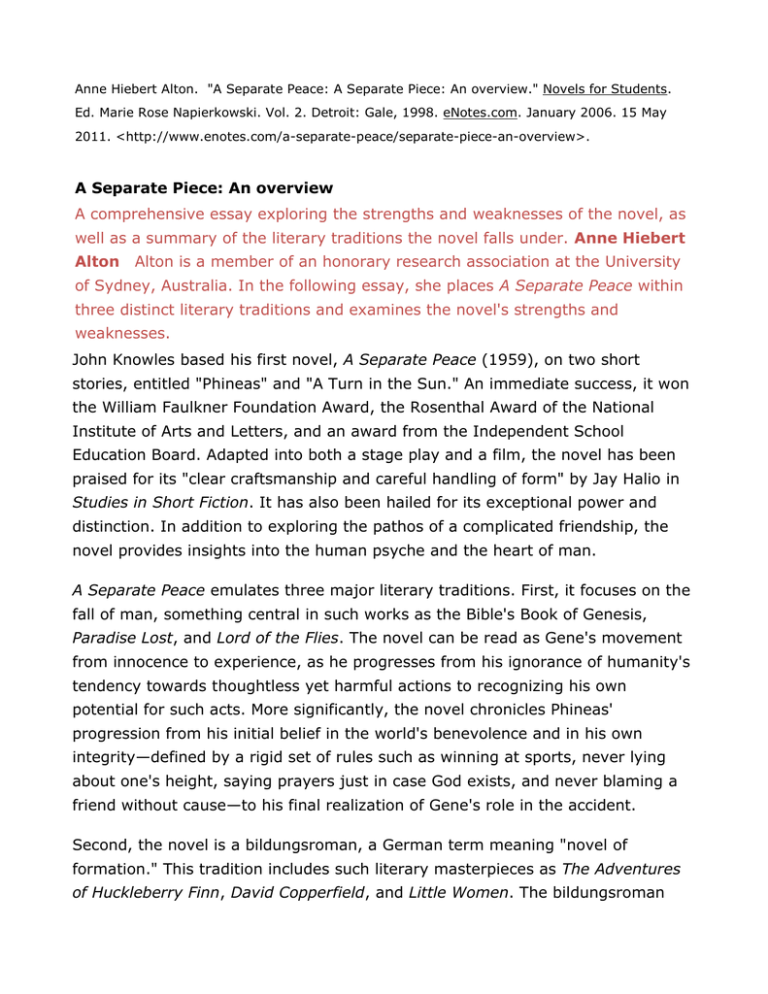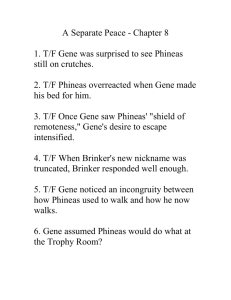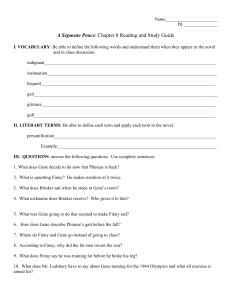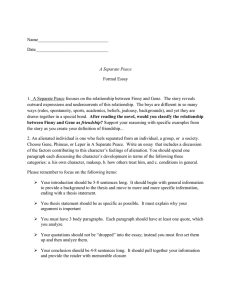Peace1 - 10Honors2011
advertisement

Anne Hiebert Alton. "A Separate Peace: A Separate Piece: An overview." Novels for Students. Ed. Marie Rose Napierkowski. Vol. 2. Detroit: Gale, 1998. eNotes.com. January 2006. 15 May 2011. <http://www.enotes.com/a-separate-peace/separate-piece-an-overview>. A Separate Piece: An overview A comprehensive essay exploring the strengths and weaknesses of the novel, as well as a summary of the literary traditions the novel falls under. Anne Hiebert Alton Alton is a member of an honorary research association at the University of Sydney, Australia. In the following essay, she places A Separate Peace within three distinct literary traditions and examines the novel's strengths and weaknesses. John Knowles based his first novel, A Separate Peace (1959), on two short stories, entitled "Phineas" and "A Turn in the Sun." An immediate success, it won the William Faulkner Foundation Award, the Rosenthal Award of the National Institute of Arts and Letters, and an award from the Independent School Education Board. Adapted into both a stage play and a film, the novel has been praised for its "clear craftsmanship and careful handling of form" by Jay Halio in Studies in Short Fiction. It has also been hailed for its exceptional power and distinction. In addition to exploring the pathos of a complicated friendship, the novel provides insights into the human psyche and the heart of man. A Separate Peace emulates three major literary traditions. First, it focuses on the fall of man, something central in such works as the Bible's Book of Genesis, Paradise Lost, and Lord of the Flies. The novel can be read as Gene's movement from innocence to experience, as he progresses from his ignorance of humanity's tendency towards thoughtless yet harmful actions to recognizing his own potential for such acts. More significantly, the novel chronicles Phineas' progression from his initial belief in the world's benevolence and in his own integrity—defined by a rigid set of rules such as winning at sports, never lying about one's height, saying prayers just in case God exists, and never blaming a friend without cause—to his final realization of Gene's role in the accident. Second, the novel is a bildungsroman, a German term meaning "novel of formation." This tradition includes such literary masterpieces as The Adventures of Huckleberry Finn, David Copperfield, and Little Women. The bildungsroman focuses on the development of the protagonist's mind and character from childhood to adulthood, charting the crises which lead to maturation and recognition of one's identity and place in the world. A Separate Peace follows Gene Forrester's progress through the formative years of his adolescence, and specifically his relationship with Phineas. Gene—short for Eugene—is Greek for "well-born." While Gene is from a Southern family affluent enough to send him to prep school, his identity isn't as secure as his name suggests: before the accident, he implies the posters on his wall of a large Southern estate represent his home. Initially Gene emulates Phineas: he joins him in climbing the tree and jumping into the river, being late for dinner, and taking a forbidden trip to the beach. Later, he wants to become Phineas, as when he tries on his clothes and feels confident "that I would never stumble through the confusions of my own character again." Phineas, too, feels their connection: after the accident, he informs Gene that he must become an athlete in Finny's stead. Later, Gene realizes that his "aid alone had never seemed to him in the category of help .... Phineas had thought of me as an extension of himself." However, as Gene matures he starts to develop his own identity. He recognizes his attraction to deadly things and, more significantly, he writes a narrative about his relationship with Phineas revealing the flaws in his own character which led to Phineas's death. Third, A Separate Peace is a boys' school story, a tradition which includes such books as Tom Brown's Schooldays, Stalky and Co., Goodbye Mr. Chips, and even Dead Poets Society. It is set in what John Rowe Townsend in Written for Children refers to as the "hothouse environment" of boarding school, a self-contained world with an aura of privilege based on class and money. Typically, such a school is a place for education and growth. Here it also represents the last place of freedom and safety for the boys, guarding their last days of childhood and standing as "the tame fringe of the last and greatest wilderness," adulthood. Moreover, it functions as a microcosm of the real world, dealing with issues of leadership, discipline, rivalry, and friendship. The novel diverges from this tradition in one respect: while pre-World War I school stories focused on what Townsend maintains were "'Games to play out, whether earnest or fun'—it was magnificent but it was not war; it had nothing to do with life and death in the trenches," A Separate Peace has everything to do with it. Gene fights his private war at school, and his actions and their effects echo the world's large-scale war. When he leaves Devon School, he feels ready to enter this war, for he no longer has any enmity to contribute Indeed, Gene comments that he never killed anyone, nor did he develop an intense hatred for the enemy, "Because my war ended before I ever put on a uniform; I was on active duty all my time at school; I killed my enemy there." In the end, Gene realizes that his real enemy is himself and his impulse towards mindless destruction—and he believes he overcame this enemy only after causing Phineas's death. One of the novel's strengths lies in its structure, and particularly its treatment of time. The narrative is designed as a story within a story, with the outer layer occurring on a dark November day. In contrast, the inner layer follows a progression through the seasons, beginning and ending in June. This cycle implies the notion of life going on despite everything, while the seasons' passing, along with the bleak winter's day at the beginning, suggest time's inevitable passage. The narrative is exceptionally good where time becomes broken into pieces on the day of Phineas' operation and death: Gene's movements at 10:10, 11:00, 11:10, 12:00, 2:30, and 4:45 are like heartbeats, which stop with Phineas's heart. Another of the novel's strengths is Knowles' remarkable economy of language. The key to many of the minor characters appears in a single phrase: Elwin "Leper" Lepellier is "the person who was most often and most emphatically taken by surprise," while Brinker Hadley cannot, "for all his self-sufficiency ... do much without company." Significant events occur almost as briefly, such as when Gene reads Leper's cryptic telegram and faces "in advance whatever the destruction was. That was what I learned to do that winter." Leper's description of Gene and Phineas on the tree limb is meticulous and evocative: "The one holding on to the trunk sank for a second, up and down like a piston, and then the other one sank and fell." The last sentence of the novel, where Gene acknowledges the truth of humanity's inherent evil, is just as precise: "this enemy they thought they saw across the frontier, this enemy who never attacked that way—if he ever attacked at all; if he was indeed the enemy." Knowles is a master of characterization, which we see best in his creation of Phineas who, as the epitome of careless grace, resembles the figurehead of a ship. Like Beowulf, Tarzan, and Hercules, Phineas has no last name; he is only Phineas. The name, which means "oracle" in Hebrew, has three-fold Biblical significance Phinehas, son of Aaron, was a judge and priest: Phineas constantly judges Gene, but always with complete integrity, and in the end offers him forgiveness. Phinehas, son of Eli, was a rebellious youth who redeemed himself by protecting the Ark: while Phineas too is rebellious, he redeems himself by embodying the essence of boyhood before the war, in his love of sport for its own sake—he breaks the swimming record simply for the challenge—and in his indefatigability, always displaying "a steady and formidable flow of usable energy." Finally, Phineas the angel was the youngest of the seventy-two angels of the Lord: like these traditional bearers of peace, Phineas is unfit for war because of his fundamental idealism. As Gene comments, once Phineas became bored with the war he'd be making friends with the enemy, chatting, and generally getting things "so scrambled up nobody would know who to fight any more." His major role is as catalyst for Gene's developing personality. By presenting Gene with his utter uniqueness, Phineas forces him to grapple with questions of identity and to confront the unrealized depths of his own character. Despite its many strengths, A Separate Peace contains a few flaws. Its detailed descriptions of setting are rarely well-integrated into the narrative. In addition, many of the minor characters (with the exception of Leper and Brinker) are poorly developed: Mr. Prud'homme appears as a foolish cipher, and the few women in the novel—such as the faculty wives, Leper's mother, or Hazel Brewster, the town belle—are mere stock characters. Furthermore, Knowles' symbolism falls short of its potential. While Gene implies that the tree holds great significance for him as something which is no longer intimidating or unique but to which he is still drawn, he goes no further with his speculations. However, this lack of development was intentional: as Knowles comments in his "The Young Writer's Real Friends," "If anything appeared which looked suspiciously like a symbol, I left it on its own .... I know that if I began with symbols, I would end with nothing; if I began with certain individuals I might end up by creating symbols." Finally, Gene's vantage point from fifteen years later is problematic, for it raises questions about the unreliability of his narrative and creates a disquieting sense of vagueness. We see Phineas only as Gene remembers him, thus Phineas is a construction of Gene's memory. In addition, Gene's refusal to pursue the question of whether or not he's truly changed is disturbing: while he insists he's improved since his days at school, noting his achievements of security and peace after having survived the war and gained worldly success, his tone suggests a lack of conviction. Moreover, though he implies that he's imbued some of Phineas' vitality, this doesn't appear in his narrative, and we're left to wonder whether he's really grown. Nevertheless, Gene's narrative provides us with one valuable insight into the effects of humanity's unthinking tendencies. After the second accident, Phineas comments to Gene: "It was just some kind of blind impulse you had in the tree there .... It wasn't anything you really felt against me, it wasn't some kind of hate you've felt all along. It wasn't anything personal." Here, Knowles makes the point that it's exactly this sort of impulsive and impersonal action which causes war, death, and conflict in the world—and it happens constantly and repeatedly. Gene supports this notion, realizing that "wars were not made by generations and their special stupidities, but that wars were made instead by something ignorant in the human heart." This is what happened between him and Phineas, and what he believes happened to bring the world to war. The real meaning of A Separate Peace lies in its title. Phineas' imaginary worlds create a peace separate from the world at war, and he invites others—and especially Gene—into this peaceful sphere. As the champion of Phineas' world, Gene delights in "this liberation we had torn from the gray encroachments of 1943, the escape we had concocted, this afternoon of momentary, illusory, special and separate peace." In the end, however, Gene arrives at his real peace—if he indeed does— apart from Phineas. Though he says that Finny's life and death taught him a way of living—"an atmosphere in which I continued now to live, a way of sizing up the world with erratic and entirely personal reservations"—he reaches this atmosphere only after separating himself from Phineas and finding his own identity. This process is ongoing, and entails Gene's acknowledgement that the real enemy is within himself and, indeed, within each of us: we're all liable to corruption from within by our own envy, anger, and fear. In the end, inner peace is achieved only after fighting one's own, private war of growing up. In this sense, the war is symbolic also of the inner struggle from adolescence to maturity.



